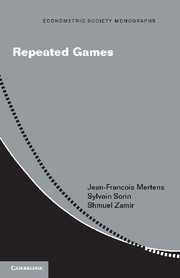Book contents
- Frontmatter
- Contents
- List of Figures
- Foreword
- Preface
- Acknowledgements
- Presentation of the Content
- Part A Background Material
- Part B The Central Results
- Part C Further Developments
- Appendix A Reminder about Analytic Sets
- Appendix B Historical Notes
- Appendix C Bibliography
- Appendix D Updates
- Author Index
- Subject Index
- Miscellaneous Endmatter
Appendix B - Historical Notes
Published online by Cambridge University Press: 05 February 2015
- Frontmatter
- Contents
- List of Figures
- Foreword
- Preface
- Acknowledgements
- Presentation of the Content
- Part A Background Material
- Part B The Central Results
- Part C Further Developments
- Appendix A Reminder about Analytic Sets
- Appendix B Historical Notes
- Appendix C Bibliography
- Appendix D Updates
- Author Index
- Subject Index
- Miscellaneous Endmatter
Summary
CHAPTER I
Section I.1 The original proof of Sion's theorem (1958) (Theorem I.1.1 in this volume) uses the KKM lemma (I.4, Ex. 18) in ℝn (which is equivalent to the fixed point theorem). However, Sion wrote “the difficulty lies in the fact that we cannot use a fixed point theorem (due to lack of continuity) nor the separation of disjoint convex sets by a hyperplane (due to lack of convexity).”
Also in Sion's paper is the proof that his theorem implies Fan's theorem (1953) (cf. the remark after Proposition I.2.7).
The proof of Sion's theorem using Lemma I.1.2, as well as the lemma itself and its proof, appears in Berge (1966, p. 220, resp. p. 172). In fact he wrote: “We note that Sion's proof led us to the statement of the intersection theorem.” On the other hand, the original proof of the lemma (Berge, 1959) also uses KKM.
A direct proof of Proposition I.1.9 was obtained by Kneser (1952) (all these results are in the Hausdorff case).
A survey and specific results for games on the square can be found in Yanovskaya (1974).
Section I.2 The proof of I.2, Ex. 17 is due to Karamata (cf., e.g., Titchmarsh, 1939, p. 227).
Section I.3 The original finite minmax theorem (I.3, Ex. 1) can be proved by “elementary tools,” namely, the theorem of the alternative (von Neumann and Morgenstern, 1944, pp. 138, 154–155) (also Ville, 1938): the iterated elimination of variables implies the existence of optimal strategies (and a fortiori the value) in the ordered field of coefficients. The first analysis in this framework and Theorem I.3.6 are due to Weyl (1950); cf. I.3, Ex. 13. This elementary aspect was used later by Bewley and Kohlberg (1976a) in analyzing stochastic games.
Another elementary proof by induction on the size of the matrix is due to Loomis (1946).
Information
- Type
- Chapter
- Information
- Repeated Games , pp. 526 - 532Publisher: Cambridge University PressPrint publication year: 2015
